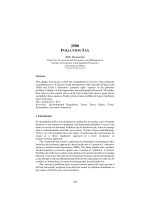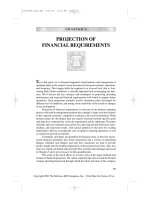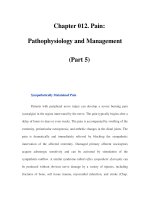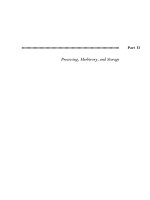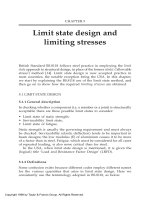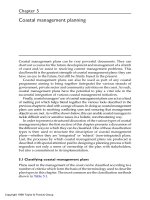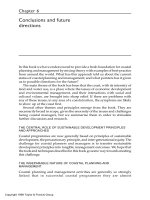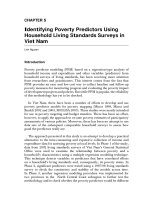Statistics for Environmental Science and Management - Chapter 5 pps
Bạn đang xem bản rút gọn của tài liệu. Xem và tải ngay bản đầy đủ của tài liệu tại đây (1.66 MB, 30 trang )
CHAPTER 5
Environmental Monitoring
5.1 Introduction
The increasing worldwide concern about threats to the natural
environment both on a local and a global scale has led to the
introduction of many monitoring schemes that are intended to provide
an early warning of violations of quality control systems, to detect the
effects of major events such as accidental oil spills or the illegal
disposal of wastes, and to study long-term trends or cycles in key
environmental variables.
Examples of some of the national monitoring schemes that are now
operating are the United States Environmental Protection Agency's
Environmental Monitoring and Assessment Program (EMAP) based
on 12,600 hexagons each with an area of 40 square kilometres, the
United Kingdom Environmental Change Network (ECN) based on nine
sites, and the Swedish Environmental Monitoring Program based on
20 sites. In all three of these schemes a large number of variables are
recorded on a regular basis to describe physical aspects of the land,
water and atmosphere, and the abundance of many species of
animals and plants. Around the world numerous smaller scale
monitoring schemes are also operated for particular purposes, such
as to ensure that the quality of drinking water is adequate.
Monitoring schemes to detect unexpected changes and trends are
essentially repeated surveys. The sampling methods described in
Chapter 2 are therefore immediately relevant. In particular, if the
mean value of a variable for the sample units in a geographical area
is of interest, then the population of units should be randomly sampled
so that the accuracy of estimates can be assessed in the usual way.
Modifications of simple random sampling such as stratified sampling
may well be useful to improve efficiency.
The requirements of environmental monitoring schemes have led
to an interest in special types of sampling designs that include aspects
of random sampling, good spatial cover, and the gradual replacement
of sampling sites over time (Skalski, 1990; Stevens and Olsen, 1991;
Overton et al., 1991; Urquhart et al., 1993; Conquest and Ralph,
1998). Designs that are optimum in some sense have also been
developed (Fedorov and Mueller, 1989; Caselton et al., 1992).
© 2001 by Chapman & Hall/CRC
Although monitoring schemes sometimes require fairly complicated
designs, as a general rule it is a good idea to keep designs as simple
as possible so that they are easily understood by administrators and
the public. Simple designs also make it easier to use the data for
purposes that were not foreseen in the first place, which is something
that will often occur. As noted by Overton and Stehman (1995,
1996), complex sample structures create potential serious difficulties
that do not exist with simple random sampling.
5.2 Purposely Chosen Monitoring Sites
For practical reasons the sites for long-term monitoring programs are
often not randomly chosen. For example, Cormack (1994) notes that
the nine sites for the United Kingdom ECN were chosen on the basis
of having:
(a) a good geographical distribution covering a wide range of
environmental conditions and the principal natural and managed
ecosystems;
(b) some guarantee of long-term physical and financial security;
(c) a known history of consistent management;
(d) reliable and accessible records of past data, preferably for ten or
more years; and
(e) sufficient size to allow the opportunity for further experiments and
observations.
In this scheme it is assumed that the initial status of sites can be
allowed for by only considering time changes. These changes can
then be related to differences between the sites in terms of measured
meteorological variables and known geographical differences.
5.3 Two Special Monitoring Designs
Skalski (1990) suggested a rotating panel design with augmentation
for long-term monitoring. This takes the form shown in Table 5.1 if
there are eight sites that are visited every year and four sets of ten
sites that are rotated. Site set 7, for example, consists of ten sites that
are visited in years 4 to 7 of the study. The number of sites in different
© 2001 by Chapman & Hall/CRC
sets is arbitrary. Preferably, the sites will be randomly chosen from an
appropriate population of sites. This design has some appealing
properties: the sites that are always measured can be used to detect
long-term trends but the rotation of blocks of ten sites ensures that the
study is not too dependent on an initial choice of sites that may be
unusual in some respects.
Table 5.1 Skalski's (1990) rotating panel design with augmentation.
Every year 48 sites are visited. Of these, 8 are always the same and the
other 40 sites are in four blocks of size ten, such that each block of ten
remains in the sample for four years after the initial start up period
Site
set
Number
of sites 1 2 3 4 5 6 7 8 9 10 11 12
0 8 x x x x x x x x x x x x
1 10 x
2 10 x x
3 10 x x x
4 10 x x x x
5 10 x x x x
6 10 x x x x
7 10 x x x x
. .
. .
. .
14 10 x x
15 10 x
The serially alternating design with augmentation that is used for
EMAP is of the form shown in Table 5.2. It differs because sites are
not rotated out of the study. Rather, there are eight sites that are
measured every year and another 160 sites in blocks of 40, where
each block of 40 is measured every four years. The number of sites
in different sets is at choice in a design of this form. Sites should be
randomly selected from an appropriate population.
Urquhart et al. (1993) compared the efficiency of the designs in
Tables 5.1 and 5.2 when there are a total of 48 sites, of which the
© 2001 by Chapman & Hall/CRC
number visited every year (i.e., in set 0) ranged from 0 to 48. To do
this, they assumed the model
Y
ijk
= S
i(j)k
+ T
j
+ e
ijk
,
where Y
ijk
is a measure of the condition at site i, in year j, within site
set k; S
i(j)k
is an effect specific to site i, in site set k, in year j, T
j
is a
year effect common to all sites, and e
ijk
is a random disturbance. They
also allowed for autocorrelation between the overall year effects, and
between the repeated measurements at one site. They found the
design of Table 5.2 to always be better for estimating the current
mean and the slope in a trend because more sites are measured in
the first few years of the study. However, in a more recent study
which compared the two designs in terms of variance and cost, Lesser
and Kalsbeek (1997) concluded that the first design tends to be better
for detecting short-term change while the second design tends to be
better for detecting long-term change.
Table 5.2 A serially alternating design with augmentation. Every year 48
sites are measured. Of these, eight sites are always the same and the
other 40 sites are measured every four years
Site
set
Number
of sites 1 2 3 4 5 6 7 8 9 10 11 12
0 8 x x x x x x x x x x x x
1 40 x x x
2 40 x x x
3 40 x x x
4 40 x x x
The EMAP sample design is based on approximately 12,600 points
on a grid, each of which is the centre of a hexagon with area 40 km².
The grid is itself within a large hexagonal region covering much of
North America, as shown in Figure 5.1. The area covered by the 40
km² hexagons entered on the grid points is one sixteenth of the total
area of the conterminous United States, with the area used being
chosen after a random shift in the grid. Another aspect of the design
is that the four sets of sites that are measured on different years are
© 2001 by Chapman & Hall/CRC
spatially interpenetrating, as indicated in Figure 5.2. This allows the
estimation of parameters for the whole area every year.
Figure 5.1 The EMAP baseline grid for North America. The shaded area
shown is covered by about 12,600 small hexagons, with a spacing between
their centres being of 27 km.
Figure 5.2 The use of spatially interpenetrating samples for visits at four
year intervals.
© 2001 by Chapman & Hall/CRC
5.4 Designs Based on Optimization
One approach to the design of monitoring schemes is by choosing the
sites so that the amount of information is in some sense maximized.
The main question then is how to measure the information that is to
be maximized, particularly if the monitoring scheme has a number of
different objectives, some of which will only become known in the
future.
One possibility involves choosing a network design, or adding or
subtracting stations to minimize entropy, where low entropy
corresponds to high 'information' (Caselton et al., 1992). The theory
is complex, and needs more prior information than will usually be
available, particularly if there is no existing network to provide this.
Another possibility considers the choice of a network design to be
a problem of the estimation of a regression function for which a
classical theory of optimal design exists (Fedorov and Mueller, 1989).
5.5 Monitoring Designs Typically Used
In practice, sample designs for monitoring often consist of selecting
a certain number of sites preferably (but not necessarily) at random
from the potential sites in a region, and then measuring the variable
of interest at those sites at a number of points in time. A complication
is that for one reason or another some of the sites may not be
measured at some of the times. A typical set of data will then look like
the data in Table 5.3 for pH values measured on lakes in Norway.
With this set of data, which is part of the more extensive data that are
shown in Table 1.1 and discussed in Example 1.2, the main question
of interest is whether there is any evidence for changes from year to
year in the general level of pH and, in particular, whether the pH level
was tending to increase or decrease.
5.6 Detection of Changes by Analysis of Variance
A relatively simple analysis for data like the Norwegian lake pH values
shown in Table 5.3 involves carrying out a two factor analysis of
variance, as discussed in Section 3.5. The two factors are then the
site and the time. The model for the observation at site i at time j is
y
ij
= µ + S
i
+ T
j
+ e
ij
, (5.1)
© 2001 by Chapman & Hall/CRC
where µ represents an overall general level for the variable being
measured, S
i
represents the deviation of site i from the general level,
T
j
represents a time effect, and e
ij
represents measurement errors and
other random variation that is associated with the observation at the
site at the particular time.
The model (5.1) does not include a term for the interaction between
sites and times as is included in the general two-factor analysis of
variance model as defined in equation (4.31). This is because there
is only at most one observation for a site in a particular year, which
means that it is not possible to separate interactions from
measurement errors. Consequently, it must be assumed that any
interactions are negligible.
Example 5.1 Analysis of Variance on the pH Values
The results of an analysis of variance on the pH values for Norwegian
lakes are summarised in Table 5.4. The results in this table were
obtained using the MINITAB package (Minitab Inc., 1994) using an
option that takes into account the missing values, although many other
standard statistical packages could have been used just as well. The
effects in the model were assumed to be fixed rather than random (as
discussed in Section 4.5), although since interactions are assumed to
be negligible the same results would be obtained using random
effects. It is found that there is a significant difference between the
lakes (p = 0.000) and a nearly significant difference between the years
(p = 0.061). Therefore there is no very strong evidence from this
analysis of differences between years.
To check the assumptions of the analysis, standardized residuals
(the differences between the actual observations and those predicted
by the model, divided by their standard deviations) can be plotted
against the lake, the year, and against their position in space for each
of the four years. These plots are shown in Figures 5.3 and 5.4.
These residuals show no obvious patterns so that the model seems
satisfactory, except that there are one or two residuals that are rather
large.
© 2001 by Chapman & Hall/CRC
Table 5.3 Values for pH for lakes in southern
Norway with the latitudes (Lat) and longitudes
(Long) for the lakes
pH
Lake Lat Long 1976 1977 1978 1981
1 58.0 7.2 4.59 4.48 4.63
2 58.1 6.3 4.97 4.60 4.96
4 58.5 7.9 4.32 4.23 4.40 4.49
5 58.6 8.9 4.97 4.74 4.98 5.21
6 58.7 7.6 4.58 4.55 4.57 4.69
7 59.1 6.5 4.80 4.74 4.94
8 58.9 7.3 4.72 4.81 4.83 4.90
9 59.1 8.5 4.53 4.70 4.64 4.54
10 58.9 9.3 4.96 5.35 5.54 5.75
11 59.4 6.4 5.31 5.14 4.91 5.43
12 58.8 7.5 5.42 5.15 5.23 5.19
13 59.3 7.6 5.72 5.73 5.70
15 59.3 9.8 5.47 5.38 5.38
17 59.1 11.8 4.87 4.76 4.87 4.90
18 59.7 6.2 5.87 5.95 5.59 6.02
19 59.7 7.3 6.27 6.28 6.17 6.25
20 59.9 8.3 6.67 6.44 6.28 6.67
21 59.8 8.9 6.06 5.80 6.09
24 60.1 12.0 5.38 5.32 5.33 5.21
26 59.6 5.9 5.41 5.94
30 60.4 10.2 5.60 6.10 5.57 5.98
32 60.4 12.2 4.93 4.94 4.91 4.93
34-1 60.5 5.5 4.90 4.87
36 60.9 7.3 5.60 5.69 5.41 5.66
38 60.9 10.0 6.72 6.59 6.39
40 60.7 12.2 5.97 6.02 5.71 5.67
41 61.0 5.0 4.68 4.72 5.02
42 61.3 5.6 5.07 5.18
43 61.0 6.9 6.23 6.34 6.20 6.29
46 61.0 9.7 6.64 6.24 6.37
47 61.3 10.8 6.15 6.23 6.07 5.68
49 61.5 4.9 4.82 4.77 5.09 5.45
50 61.5 5.5 5.42 4.82 5.34 5.54
57 61.7 4.9 4.99 5.16 5.25
58 61.7 5.8 5.31 5.77 5.60 5.55
59 61.9 7.1 6.26 5.03 5.85
65 62.2 6.4 5.99 6.10 5.99 6.13
80 58.1 6.7 4.63 4.59 4.92
81 58.3 8.0 4.47 4.36 4.50
82 58.7 7.1 4.60 4.54 4.66
83 58.9 6.1 4.88 4.99 4.86 4.92
85 59.4 11.3 4.60 4.88 4.91 4.84
86 59.3 9.4 4.85 4.65 4.77 4.84
87 59.2 7.6 5.06 5.15 5.11
88 59.4 7.3 5.97 5.82 5.90 6.17
89 59.3 6.3 5.47 6.05 5.82
94 61.0 11.5 6.05 5.97 5.78 5.75
95-1 61.2 4.6 5.70 5.50
Mean 5.34 5.40 5.31 5.38
SD 0.65 0.66 0.57 0.56
© 2001 by Chapman & Hall/CRC
Table 5.4 Analysis of variance table for the data on pH levels in Norwegian
lakes
Source of
Variation
Sum of
Squares
1
Degrees
of
Freedom
Mean
Square F
Signif-
icance
level (p)
Lake 58.70 47 1.249 37.95 0.000
Year 0.25 3 0.083 2.53 0.061
Error 3.85 117 0.033
Total 62.80 167
1
The sums of squares shown here depend on the order in which effects are added
into the model, which is species, then the treatment, and finally the interaction
between these two factors.
Figure 5.3 Standardized residuals from the analysis of variance model for
pH in Norwegian lakes plotted against the lake number and the year
number.
5.7 Detection of Changes Using Control Charts
Control charts are used to monitor industrial processes (Montgomery,
1991) and they can be used equally well with environmental data. The
simplest approach involves using an x
chart to detect changes in a
process mean, together with a range chart to detect changes in the
amount of variation. These types of charts are often called Shewhart
control charts after their originator (Shewhart, 1931).
Typically, the starting point is a moderately large set of data
consisting of M random samples of size n, where these are taken at
equally spaced intervals of time from the output of the process. This
set of data is then used to estimate the process mean and standard
deviation, and hence to construct the two charts. The data are then
© 2001 by Chapman & Hall/CRC
plotted on the charts. It is usually assumed that the observations are
normally distributed.
If the process seems to have a constant mean and standard
deviation, then the sampling of the process is continued with new
points being plotted to monitor whatever is being measured. If the
mean or standard deviation does not seem to have been constant for
the time when the initial samples were taken, then in the industrial
process situation, action is taken to bring the process under control.
With environmental monitoring this may not be possible. However,
the knowledge that the process being measured is not stable will be
of interest anyway.
Figure 5.4 Standardized residuals from the analysis of variance model for
pH in Norwegian lakes plotted against the locations of the lakes. The
standardized residuals are rounded to the nearest integer for clarity.
The method for constructing the x-chart involves the following
stages:
© 2001 by Chapman & Hall/CRC
1. The sample mean and the sample range (the maximum value in a
sample minus the minimum value in a sample) are calculated, for
each of the M samples. For the ith sample let these values be
denoted by x
i
and R
i
.
2. The mean of the variable being measured is assumed to be
constant, and is estimated by the overall mean of all the available
observations, which is also just the mean of the sample means x
1
to x
M
. Let the estimated mean be denoted by µ.
3. Similarly, the standard deviation of ring widths is assumed to have
remained constant and this is estimated on the basis of a known
relationship between the mean range for samples of size n and the
standard deviation for samples from a normal distribution. This
relationship is of the form F = k(n)µ
R
, where µ
R
is the mean range
for samples of size n, and the constant k(n) is given in Table 5.5.
Thus the estimated standard deviation is
F
= k(n)R
-
, (5.2)
where R
-
is the mean of the sample ranges.
4. The standard error of the mean for samples of size n is estimated
to be SÊ(x
) = F/%n.
5. Warning limits are set at the mean plus and minus 1.96 standard
errors, i.e., at µ
± 1.96SÊ(x) . If the mean and standard deviation
are constant then only about 1 in 20 (5%) sample means should be
outside one of these limits. Action limits are set at the mean plus
and minus 3.09 standard errors, i.e., at µ
± 3.09SÊ(x) . Only about
1 in 500 (0.2%) sample means should plot outside these limits.
The rationale behind constructing the x
chart in this way is that it
shows the changes in the sample means with time, and the warning
and action limits indicate whether these changes are too large to be
due to normal random variation if the mean is in fact constant.
© 2001 by Chapman & Hall/CRC
Table 5.5 Control chart limits for sample ranges, assuming samples from
normal distributions. To find the limits on the range chart, multiply the
mean range by the tabulated value. For example, for samples of size n =
5 the lower action limit is 0.16µ
R
, where µ
R
is the mean range. With a
stable distribution a warning limit is crossed with probability 0.05 (5%) and
an action limit with probability 0.002 (0.2%). The last column is the factor
that the mean range must be multiplied by to obtain the standard deviation.
For example, for samples of size 3 the standard deviation is 0.591µ
R
.
Source: Tables G1 and G2 of Davies and Goldsmith (1972)
Sample Lower limits Upper limits SD
size Action Warning Warning Action Factor (k)
2 0.00 0.04 2.81 4.12 0.887
3 0.04 0.18 2.17 2.99 0.591
4 0.10 0.29 1.93 2.58 0.486
5 0.16 0.37 1.81 2.36 0.430
6 0.21 0.42 1.72 2.22 0.395
7 0.26 0.46 1.66 2.12 0.370
8 0.29 0.50 1.62 2.04 0.351
9 0.32 0.52 1.58 1.99 0.337
10 0.35 0.54 1.56 1.94 0.325
With control charts it is conventional to measure process variability
using sample ranges on the grounds of simplicity, although standard
deviations or variances could be used instead. Like x
charts, range
charts can have warning limits placed so that the probability of
crossing one of these is 0.05 (5%), assuming that the level of variation
is stable. Similarly, action limits can be placed so that the probability
of crossing one of them is 0.002 (0.2%) when the level of variation is
stable. The setting of these limits requires the use of tabulated values
that are provided and explained in Table 5.5.
Control charts can be produced quite easily in a spreadsheet
program. Alternatively, statistical package such as MINITAB (Mintab
Inc., 1994) have options to produce the charts, and often allow a
number of other types of control charts to be produced as well.
Example 5.2 Monitoring pH in New Zealand
Table 5.6 shows some data that were obtained from regular
monitoring of rivers in the South Island of New Zealand. Values are
provided for pH, for five randomly chosen rivers, with a different
selection for each of the monthly sample times from January 1989 to
December 1997. The data are used to construct control charts for
© 2001 by Chapman & Hall/CRC
monitoring pH over the sampled time. As shown in Figure 5.5, the
distribution is reasonably close to normal.
The overall mean of the pH values for all the samples is µ
^
= 7.640.
This is used as the best estimate of the process mean. The mean of
the sample ranges is R
-
= 0.694. From Table 5.5, the factor to convert
this to an estimate of the process standard deviation is k(5) = 0.43.
The estimated standard deviation is therefore
F
^
= 0.43 x 0.694 = 0.298.
Hence, the estimated standard error for the sample means is
SÊ(x
) = 0.298/%5 = 0.133.
The mean control chart is shown in Figure 5.6 (a), with the action
limits set at 7.640 ± 3.09 x 0.133 (i.e., 7.23 and 8.05), and the warning
limits at 7.640 ± 1.96 x 0.133 (i.e., 7.38 and 7.90).
The range chart is shown in Figure 5.6 (b). Using the factors for
setting the action and warning limits from Table 5.5, these limits are
at are 0.16 x 0.694 = 0.11 (lower action limit), 0.37 x 0.694 = 0.26
(lower warning limit), 1.81 x 0.694 = 1.26 (upper warning limit), and
2.36 x 0.694 = 1.64 (upper action limit). Due to the nature of the
distribution of sample ranges, these limits are not symmetrically
placed about the mean.
With 108 observations altogether, it is expected that about five
points will plot outside the warning limits. In fact, there are ten points
outside these limits, and one point outside the lower action limit. It
appears, therefore, that the mean pH level in the South Island of New
Zealand was changing to some extent during the monitored period,
with the overall plot suggesting that the pH level was high for about
the first two years, and was lower from then on.
The range chart has seven points outside the warning limits, and
one point above the upper action limit. Here again there is evidence
that the process variation was not constant, with occasional 'spikes'
of high variability, particularly in the early part of the monitoring period.
© 2001 by Chapman & Hall/CRC
Table 5.6 Values for pH for five randomly selected rivers in the South
Island of New Zealand, for each month from January 1989 to December
1997. This is part of a larger data set provided by Graham McBride,
National Institute of Water and Atmospheric Research, Hamilton, New
Zealand
Year Month pH Values Mean Range
1989 Jan 7.27 7.10 7.02 7.23 8.08 7.34 1.06
Feb 8.04 7.74 7.48 8.10 7.21 7.71 0.89
Mar 7.50 7.40 8.33 7.17 7.95 7.67 1.16
Apr 7.87 8.10 8.13 7.72 7.61 7.89 0.52
May 7.60 8.46 7.80 7.71 7.48 7.81 0.98
Jun 7.41 7.32 7.42 7.82 7.80 7.55 0.50
Jul 7.88 7.50 7.45 8.29 7.45 7.71 0.84
Aug 7.88 7.79 7.40 7.62 7.47 7.63 0.48
Sep 7.78 7.73 7.53 7.88 8.03 7.79 0.50
Oct 7.14 7.96 7.51 8.19 7.70 7.70 1.05
Nov 8.07 7.99 7.32 7.32 7.63 7.67 0.75
Dec 7.21 7.72 7.73 7.91 7.79 7.67 0.70
1990 Jan 7.66 8.08 7.94 7.51 7.71 7.78 0.57
Feb 7.71 8.73 8.18 7.04 7.28 7.79 1.69
Mar 7.72 7.49 7.62 8.13 7.78 7.75 0.64
Apr 7.84 7.67 7.81 7.81 7.80 7.79 0.17
May 8.17 7.23 7.09 7.75 7.40 7.53 1.08
Jun 7.79 7.46 7.13 7.83 7.77 7.60 0.70
Jul 7.16 8.44 7.94 8.05 7.70 7.86 1.28
Aug 7.74 8.13 7.82 7.75 7.80 7.85 0.39
Sep 8.09 8.09 7.51 7.97 7.94 7.92 0.58
Oct 7.20 7.65 7.13 7.60 7.68 7.45 0.55
Nov 7.81 7.25 7.80 7.62 7.75 7.65 0.56
Dec 7.73 7.58 7.30 7.78 7.11 7.50 0.67
1991 Jan 8.52 7.22 7.91 7.16 7.87 7.74 1.36
Feb 7.13 7.97 7.63 7.68 7.90 7.66 0.84
Mar 7.22 7.80 7.69 7.26 7.94 7.58 0.72
Apr 7.62 7.80 7.59 7.37 7.97 7.67 0.60
May 7.70 7.07 7.26 7.82 7.51 7.47 0.75
Jun 7.66 7.83 7.74 7.29 7.30 7.56 0.54
Jul 7.97 7.55 7.68 8.11 8.01 7.86 0.56
Aug 7.86 7.13 7.32 7.75 7.08 7.43 0.78
Sep 7.43 7.61 7.85 7.77 7.14 7.56 0.71
Oct 7.77 7.83 7.77 7.54 7.74 7.73 0.29
Nov 7.84 7.23 7.64 7.42 7.73 7.57 0.61
Dec 8.23 8.08 7.89 7.71 7.95 7.97 0.52
© 2001 by Chapman & Hall/CRC
Table 5.6 (Continued)
Year Month pH Values Mean Range
1992 Jan 8.28 7.96 7.86 7.65 7.49 7.85 0.79
Feb 7.23 7.11 8.53 7.53 7.78 7.64 1.42
Mar 7.68 7.68 7.15 7.68 7.85 7.61 0.70
Apr 7.87 7.20 7.42 7.45 7.96 7.58 0.76
May 7.94 7.35 7.68 7.50 7.12 7.52 0.82
Jun 7.80 6.96 7.56 7.22 7.76 7.46 0.84
Jul 7.39 7.12 7.70 7.47 7.74 7.48 0.62
Aug 7.42 7.41 7.47 7.80 7.12 7.44 0.68
Sep 7.91 7.77 6.96 8.03 7.24 7.58 1.07
Oct 7.59 7.41 7.41 7.02 7.60 7.41 0.58
Nov 7.94 7.32 7.65 7.84 7.86 7.72 0.62
Dec 7.64 7.74 7.95 7.83 7.96 7.82 0.32
1993 Jan 7.55 8.01 7.37 7.83 7.51 7.65 0.64
Feb 7.30 7.39 7.03 8.05 7.59 7.47 1.02
Mar 7.80 7.17 7.97 7.58 7.13 7.53 0.84
Apr 7.92 8.22 7.64 7.97 7.18 7.79 1.04
May 7.70 7.80 7.28 7.61 8.12 7.70 0.84
Jun 7.76 7.41 7.79 7.89 7.36 7.64 0.53
Jul 8.28 7.75 7.76 7.89 7.82 7.90 0.53
Aug 7.58 7.84 7.71 7.27 7.95 7.67 0.68
Sep 7.56 7.92 7.43 7.72 7.21 7.57 0.71
Oct 7.19 7.73 7.21 7.49 7.33 7.39 0.54
Nov 7.60 7.49 7.86 7.86 7.80 7.72 0.37
Dec 7.50 7.86 7.83 7.58 7.45 7.64 0.41
1994 Jan 8.13 8.09 8.01 7.76 7.24 7.85 0.89
Feb 7.23 7.89 7.81 8.12 7.83 7.78 0.89
Mar 7.08 7.92 7.68 7.70 7.40 7.56 0.84
Apr 7.55 7.50 7.52 7.64 7.14 7.47 0.50
May 7.75 7.57 7.44 7.61 8.01 7.68 0.57
Jun 6.94 7.37 6.93 7.03 6.96 7.05 0.44
Jul 7.46 7.14 7.26 6.99 7.47 7.26 0.48
Aug 7.62 7.58 7.09 6.99 7.06 7.27 0.63
Sep 7.45 7.65 7.78 7.73 7.31 7.58 0.47
Oct 7.65 7.63 7.98 8.06 7.51 7.77 0.55
Nov 7.85 7.70 7.62 7.96 7.13 7.65 0.83
Dec 7.56 7.74 7.80 7.41 7.59 7.62 0.39
1995 Jan 8.18 7.80 7.22 7.95 7.79 7.79 0.96
Feb 7.63 7.88 7.90 7.45 7.97 7.77 0.52
Mar 7.59 8.06 8.22 7.57 7.73 7.83 0.65
Apr 7.47 7.82 7.58 8.03 8.19 7.82 0.72
May 7.52 7.42 7.76 7.66 7.76 7.62 0.34
Jun 7.61 7.72 7.56 7.49 6.87 7.45 0.85
Jul 7.30 7.90 7.57 7.76 7.72 7.65 0.60
Aug 7.75 7.75 7.52 8.12 7.75 7.78 0.60
Sep 7.77 7.78 7.75 7.49 7.14 7.59 0.64
Oct 7.79 7.30 7.83 7.09 7.09 7.42 0.74
Nov 7.87 7.89 7.35 7.56 7.99 7.73 0.64
Dec 8.01 7.56 7.67 7.82 7.44 7.70 0.57
© 2001 by Chapman & Hall/CRC
Table 5.6 (Continued)
Year Month pH Values Mean Range
1996 Jan 7.29 7.62 7.95 7.72 7.98 7.71 0.69
Feb 7.50 7.50 7.90 7.12 7.69 7.54 0.78
Mar 8.12 7.71 7.20 7.43 7.56 7.60 0.92
Apr 7.64 7.75 7.80 7.72 7.73 7.73 0.16
May 7.59 7.57 7.86 7.92 7.22 7.63 0.70
Jun 7.60 7.97 7.14 7.72 7.72 7.63 0.83
Jul 7.07 7.70 7.33 7.41 7.26 7.35 0.63
Aug 7.65 7.68 7.99 7.17 7.72 7.64 0.82
Sep 7.51 7.64 7.25 7.82 7.91 7.63 0.66
Oct 7.81 7.53 7.88 7.11 7.50 7.57 0.77
Nov 7.16 7.85 7.63 7.88 7.66 7.64 0.72
Dec 7.67 8.05 8.12 7.38 7.77 7.80 0.74
1997 Jan 7.97 7.04 7.48 7.88 8.24 7.72 1.20
Feb 7.17 7.69 8.15 6.96 7.47 7.49 1.19
Mar 7.52 7.84 8.12 7.85 8.07 7.88 0.60
Apr 7.65 7.14 7.38 7.23 7.66 7.41 0.52
May 7.62 7.64 8.17 7.56 7.53 7.70 0.64
Jun 7.10 7.16 7.71 7.57 7.15 7.34 0.61
Jul 7.85 7.62 7.68 7.71 7.72 7.72 0.23
Aug 7.39 7.53 7.11 7.39 7.03 7.29 0.50
Sep 8.18 7.75 7.86 7.77 7.77 7.87 0.43
Oct 7.67 7.66 7.87 7.82 7.51 7.71 0.36
Nov 7.57 7.92 7.72 7.73 7.47 7.68 0.45
Dec 7.97 8.16 7.70 8.21 7.74 7.96 0.51
Mean 7.640 0.694
Figure 5.5 Histogram of the distribution of pH for samples from lakes in the
South Island of New Zealand, 1989 to 1997.
© 2001 by Chapman & Hall/CRC
(a) x Chart
(b) Range Chart
Figure 5.6 Control charts for pH levels in rivers in the South Island of New
Zealand. For a process that is stable, about 1 in 40 points should plot
outside one of the warning limits (LWL and UWL) and only about 1 in 1000
points should plot outside one of the action limits (LAL and UAL).
As this example demonstrates, control charts are a relatively
simple tool for getting some insight into the nature of the process
being monitored, through the use of the action and control limits,
which indicate the level of variation expected if the process is stable.
See a book on industrial process control such as the one by
Montgomery (1991) for more details about the use of x
and range
charts, as well as a number of other types of charts that are intended
to detect changes in the average level and the variation in processes.
© 2001 by Chapman & Hall/CRC
5.8 Detection of Changes Using CUSUM Charts
An alternative to the x
chart that is sometimes used for monitoring the
mean of a process is a CUSUM chart, as proposed by Page (1961).
With this chart, instead of plotting the means of successive samples
directly, the differences between the sample means and the desired
target mean are calculated and summed. Thus if the means of
successive samples are x
1
, x
2
, x
3
, and so on, then S
1
= (x
1
- µ) is
plotted against sample number 1, S
2
= (x
1
- µ) + (x
2
- µ) is plotted
against sample number 2, S
3
= (x
1
- µ) + (x
2
- µ) + (x
3
- µ) is plotted
against sample number 3, and so on, where µ is the target mean of
the process. The idea is that because deviations from the target
mean are accumulated, this type of chart will show small deviations
from the target mean more quickly than the traditional x
chart. See
MacNally and Hart (1997) for an environmental application.
Setting control limits for CUSUM charts is more complicated than
it is for an x
chart (Montgomery, 1991), and the details will not be
considered here. There is, however, a variation on the usual CUSUM
approach that will be discussed because of its potential value for
monitoring under circumstances where repeated measurements are
made on the same sites at different times. That is to say, the data are
like the pH values for a fixed set of Norwegian lakes shown in Table
5.3, rather than the pH values for random samples of New Zealand
rivers shown in Table 5.6.
This method proceeds as follows (Manly, 1994; Manly and
MacKenzie, 2000). Suppose that there are n sample units measured
at m different times. Let x
ij
be the measurement on sample unit i at
time t
j
, and let x
i
be the mean of all the measurements on the unit.
Assume that the units are numbered in order of their values for x
i
, so
that x
1
is the smallest mean and x
n
is the largest mean. Then it is
possible to construct m CUSUM charts by calculating
S
ij
= (x
1j
- x
1
) + (x
2j
- x
2
) + + (x
ij
- x
i
), (5.3)
for j from 1 to m and i from 1 to n, and plotting the S
ij
values against i,
for each of the m sample times.
The CUSUM chart for time t
j
indicates the manner in which the
observations made on sites at that time differ from the average values
for all sample times. For example a positive slope for the CUSUM
shows that the values for that time period are higher than the average
values for all periods. Furthermore, a CUSUM slope of D for a series
of sites (the rise divided by the number of observations) indicates that
the observations on those sites are on average D higher than the
corresponding means for the sites over all sample times. Thus a
© 2001 by Chapman & Hall/CRC
constant difference between the values on a sample unit at one time
and the mean for all times is indicated by a constant slope of the
CUSUM going either up or down from left to right. On the other hand,
a positive slope on the left-hand side of the graph followed by a
negative slope on the right-hand side indicates that the values at the
time being considered were high for sites with a low mean but low for
sites with a high mean. Figure 5.7 illustrates some possible patterns
that might be obtained, and their interpretation.
Randomization methods can be used to decide whether the
CUSUM plot for time t
j
indicates systematic differences between the
data for this time and the average for all times. In brief, four
approaches based on the null hypothesis that the values for each
sample unit are in a random order with respect to time are:
(a) A large number of randomized CUSUM plots can be constructed,
where for each one of these the observations on each sample unit
are randomly permuted. Then, for each value of i, the maximum
and minimum values obtained for S
ij
can be plotted on the CUSUM
chart. This gives an envelope within which any CUSUM plot for
real data can be expected to lie, as shown in Figure 5.8. If the real
data plot goes outside the envelope, then there is clear evidence
that the null hypothesis is not true.
(b) Using the randomizations it is possible to determine whether S
ij
is
significantly different from 0 for any particular values of i and j.
Thus if there are R-1 randomizations, then the observed value of
S
ij
is significantly different from 0 at the 100"% level if it is among
the largest 100"% of the R values of
S
ij
consisting of the
observed value and the R-1 randomizations.
(c) To obtain a statistic that measures the overall extent to which a
CUSUM plot differs from what is expected on the basis of the null
hypothesis, the standardized deviation of S
ij
from zero,
Z
ij
= S
ij
/%Var(S
ij
),
is calculated for each value of i. A measure of the overall deviation
of the jth CUSUM from 0 is then
Z
max,j
= Max( Z
1j
, Z
2j
, , Z
nj
).
The value of Z
max,j
for the observed data is significantly large at the
100"% level if it is among the largest 100"% of the R values
© 2001 by Chapman & Hall/CRC
consisting of itself plus R-1 other values obtained by
randomization.
Figure 5.7 Some examples of possible CUSUM plots for a particular time
period: (a) all the sites tend to have high values for this period; (b) all the
sites tend to have low values for this period; (c) sites with a low mean for all
periods tend to have relatively high values for this period, but sites with a
high mean for all periods tend to have low values for this period; and (d)
sites with a low mean for all periods tend to have even lower low values in
this period, but sites with a high mean for all periods tend to have values
close to this mean for this period.
(d) To measure the extent to which the CUSUM plots for all times
differ from what is expected from the null hypothesis the statistic
Z
max,T
= Z
max,1
+ Z
max,2
+ + Z
max,m
can be used. Again, the Z
max,T
for a set of observed data is
significantly large at the 100"% level if it is among the largest
© 2001 by Chapman & Hall/CRC
100"% of the R values consisting of itself plus R-1 comparable
values obtained from randomized data.
See Manly (1994) and Manly and MacKenzie (2000) for more
details about how these tests are made.
Figure 5.8 Example of a randomization envelope obtained for a CUSUM
plot. For each site in order the minimum and maximum (as indicated by
broken lines) are those obtained from all the randomized data sets for the
order number being considered. For example, with 1000 randomizations,
all of the CUSUM plots obtained from the randomized data are contained
within the envelope. In this example the observed CUSUM plot is well within
the randomization limits.
Missing values can be handled easily. If x
ij
is not measured then
it can be set equal to x
i
for calculating the CUSUM using equation
(5.3), where x
i
is the mean of the observations that are present, while
in equation (5.4) Var(d
k
) can be modified to equal the variance for the
observations that are present. For the randomization tests only the
observations that are present are randomly permuted on a sample
unit.
The way that the CUSUM values are calculated using equation
(5.3) means that any average differences between sites are allowed
for, so that there is no requirement for the mean values at different
© 2001 by Chapman & Hall/CRC
sites to be similar. However, for the randomization tests there is an
implicit assumption that there is negligible serial correlation between
the successive observations at one sampling site, i.e., there is no
tendency for these observations to be similar because they are
relatively close in time. If this is not the case, as may well happen for
many monitored variables, then it is possible to modify the
randomization tests to allow for this. A method to do this is described
by Manly and MacKenzie (2000), who also compare the power of the
CUSUM procedure with the power of other tests for systematic
changes in the distribution of the variable being studied. This
modification will not be considered here.
The calculations for the CUSUM method are fairly complicated,
particularly when serial correlation is involved. A Windows computer
program called CAT (Cusum Analysis Tool) to do these calculations
can be downloaded from the web site www.niwa.cri.nz/
.
Example 5.3 CUSUM Analysis of pH Data
As an example of the use of the CUSUM procedure, consider again
the data from a Norwegian research programme that are shown in
Table 5.3. Figure 5.9 shows the plots for the years 1976, 1977, 1978
and 1981, each compared to the mean for all years. It appears that
the pH values in 1976 were generally close to the mean, with the
CUSUM plots falling well within the limits found from 9,999
randomizations, and the Z
max
value (1.76) being quite unexceptional
(p = 0.48). For 1977 there is some suggestion of pH values being low
for lakes with a low mean but the Z
max
value (2.46) is not particularly
large (p = 0.078). For 1978 there is also little evidence of differences
from the mean for all years (Z
max
= 1.60; p = 0.626). However, for
1981 it is quite another matter. The CUSUM plot even exceeds some
of the upper limits obtained from 9,999 randomizations, and the
observed Z
max
value (3.96) is most unlikely to have been obtained by
chance (p = 0.0002). Thus there is very clear evidence that the pH
values in 1981 were higher than in the other years, although the
CUSUM plot shows that the differences were largely on the lakes with
relatively low mean pH levels because it becomes quite flat on the
right-hand side of the graph.
The sum of the Z
max
values for all four years is Z
max,T
= 9.79. From
the randomizations, the probability of obtaining a value this large is
0.0065, giving clear evidence systematic changes in the pH levels of
the lakes, for the years considered together.
© 2001 by Chapman & Hall/CRC
Figure 5.9 CUSUM plots for 1976, 1977, 1978 and 1981 compared to the mean for all years. The horizontal axis corresponds to lakes
in the order of mean pH values for the four years. For each plot the upper and lower continuous lines are the limits obtained from 9,999
randomized sets of data and the CUSUM is the line with open boxes. The p-value with each plot is the probability of obtaining a plot
as extreme or more extreme than the one obtained.
© 2001 by Chapman & Hall/CRC
© 2001 by Chapman & Hall/CRC
5.9 Chi-Squared Tests for a Change in a Distribution
Stehman and Overton (1994) describe a set of tests for a change in a
distribution, which they suggest will be useful as a screening device.
These tests can be used whenever observations are available on a
random sample of units at two times. If the first observation in a pair is
x and the second one is y, then y is plotted against x and three chi-
squared calculations are made, as shown on Figure 5.10.
The first test compares the number of points above a 45 degree line
with the number below, as indicated in Figure 5.10. A significant
difference indicates an overall shift in the distribution either upward
(most points above the 45 degree line) or downward (most points below
the 45 degree line). In Figure 5.10 there are 30 points above the line
and 10 points below. The expected counts are both 20 if x and y are
from the same distribution.
The one sample chi-squared test (Appendix Section A4) is used to
compare the observed and expected frequencies. The test statistic is
E(O - E)
2
/E, where O is an observed frequency, E an expected
frequency, and the summation is over all such frequencies. Thus for
the situation being considered, the statistic is
(30 - 20)²/20 + (10 - 20)²/20 = 10.00,
with 1 degree of freedom (df). This is significantly large at the 1% level,
giving clear evidence of a shift in the general level of observations.
Because most plotted points are above the 45 degree line the
observations tend to be higher at the second sample time than at the
first sample time.
© 2001 by Chapman & Hall/CRC
Figure 5.10 Test for a shift in a distribution by counting points above and
below the line y = x.
For the second test, the line at 45 degrees is shifted upward or
downward so that an equal number of points are above and below it.
Counts are then made of the number of points in four quadrats, as
shown in Figure 5.11. The counts then form a 2x2 contingency table,
and the contingency table chi-squared test (Appendix Section A4) can
be used to see whether the counts above and below the line are
significantly different. A significant result indicates a change in shape
of the distribution from one time period to the next. In Figure 5.11 the
observed counts are
10 10
10 10.
These are exactly equal to the expected counts on the assumption that
the probability of a point plotting above the line is the same for high and
low observations, leading to a chi-squared value of zero with 1 df.
There is therefore no evidence of a change in shape of the distribution
from this test.
© 2001 by Chapman & Hall/CRC
